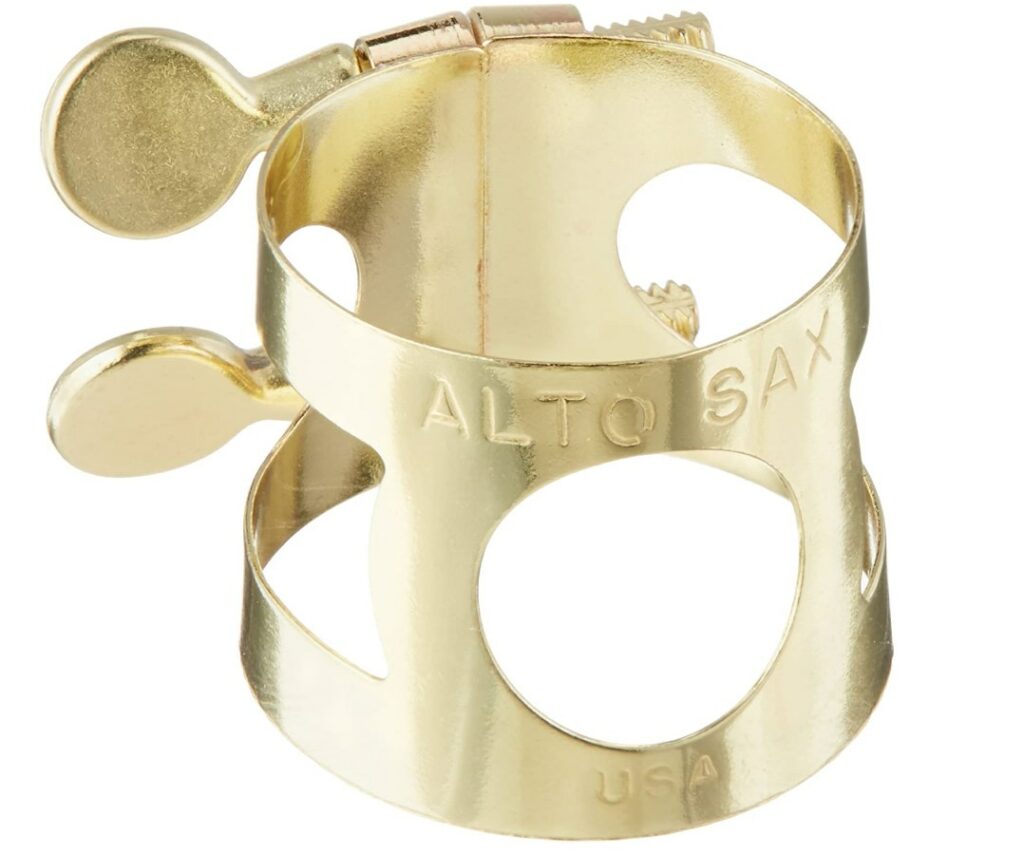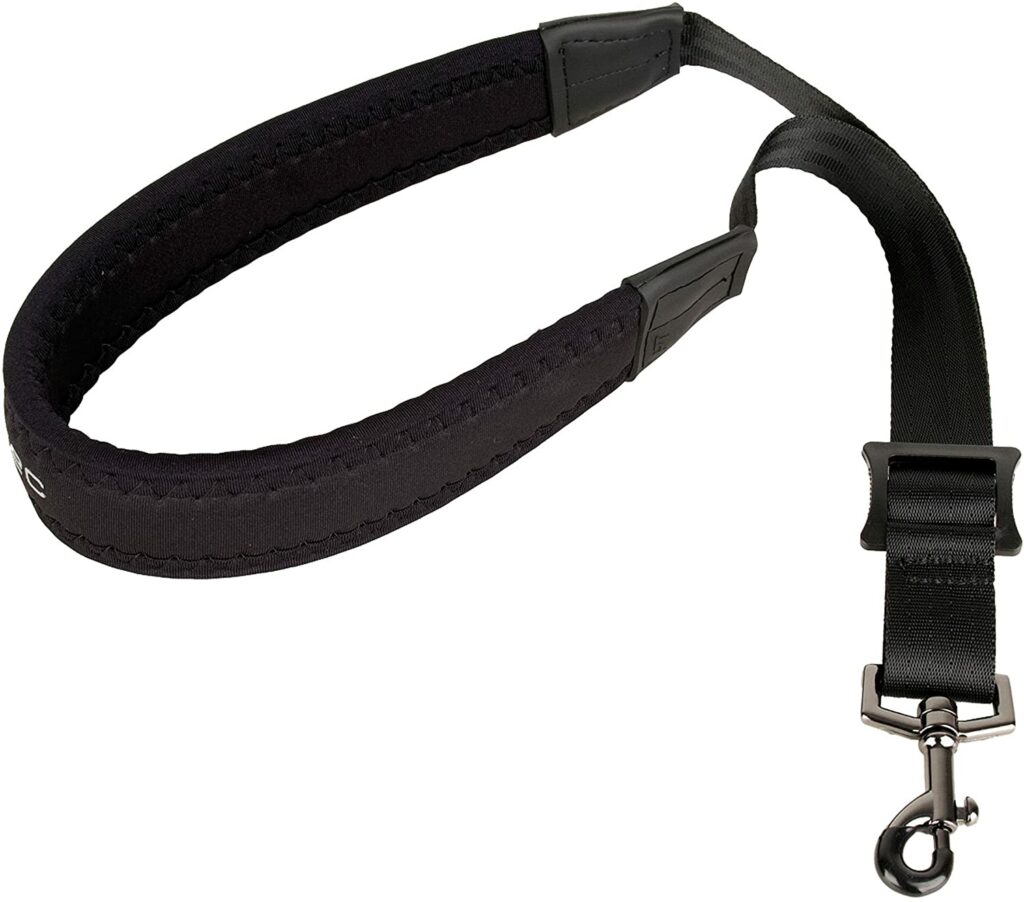- Top Trumpet Embouchure Techniques: Options for Beginners Through Professionals - October 12, 2022
- Is the Trumpet Hard to Learn? - September 30, 2022
- Best Leblanc Clarinet Models Guide: From Soprano to Contrabass - September 5, 2022
Years ago, I made a big mistake and left my alto saxophone on its stand overnight. Someone then dropped a guitar on the saxophone, and I had to take it in for repairs. Luckily, I’d had key saxophone parts explained to me, so I knew what was wrong.
At the moment, I was so embarrassed because putting my saxophone away would have taken a couple of minutes. But looking back, it’s a funny story. It’s also proof that saxophone players should know the parts of their instrument. If something goes wrong, you will be able to fix it or have a professional fix it for you.
Mouthpiece

The saxophone part that you’ll get to know the most is the mouthpiece. It’s what you put your lips and teeth on to make a sound, so it’s a crucial piece of the saxophone puzzle. Having a good mouthpiece can make it easier to play certain things, and many players will upgrade to a different mouthpiece. You can get a new mouthpiece for your soprano saxophone to help change the sound.
And if you have an alto saxophone but want an easy upgrade, you should look for a new mouthpiece. These parts are much more affordable than buying a new instrument. When switching to the tenor saxophone or baritone saxophone, you’ll also need different mouthpieces to fit. That way, you can get the right sound for that particular sax.
Ligature

Along with a mouthpiece, you need a quality ligature. The ligature is a piece of metal or fabric that goes around the mouthpiece and keeps the reed in place. Metal ligatures are more common among students, and they’re affordable and easy to find. However, fabric ligatures allow the reed to vibrate more freely, which can be essential as you advance.
Even if you like your current tenor saxophone mouthpiece, you can get a new ligature to potentially change how your instrument sounds or feels to play.
Reed

You can’t make a sound on any saxophone without a good saxophone reed. Reeds come in a variety of strengths, so some are thicker and more resistant than others. Saxophone players may switch between different reeds to help get an amazing sound. For example, one reed might sound great when playing jazz, but it might be too much for a classical concert band.
Unfortunately, reeds don’t last very long, so you’ll need to buy them frequently. But that does mean you can switch things up if you stop liking how one reed sounds.
Neck
The neck is the next part of the saxophone, and it’s the start of where the air gets to vibrate and make notes. You’ll put the mouthpiece on the small end of the neck, usually over some cork. A saxophone neck is pretty simple, but it does have a small tone hole that goes with the octave key on the body. Opening that tone hole brings the pitch up, so you can play higher notes.
The neck can look different on different saxophone sizes. For example, the alto saxophone has a neck with one angle, while the tenor saxophone neck has more of a curve. A baritone saxophone neck wraps around because it’s so long, so it looks like a loop near the top. When you play a soprano saxophone, the neck might not even be separate from the body, and it usually doesn’t have any angle to it.
Body
The body of the saxophone is where you can find many key parts (pun intended), from keys to the saxophone bell. Overall, many saxophone bodies have a similar shape, especially the alto and tenor. While some soprano saxophones have the same J curve, a lot of sopranos are straight, so they look more like clarinets. Baritone saxophones have a curve, and the bell part is almost as long as the rest of the body.
As you look at a saxophone body, consider the various parts, what they do, and why they matter.
Main Keys
While not an official name, the main keys are those you play with the first three fingers on your left and right hands. They allow you to play some of the first notes you learn on the alto or tenor saxophone. With your left hand, you can play C using your middle finger, B using your first finger, and A using both. Add your ring finger to get the note G.
If you add your right-hand first finger, you can get the note F, whereas adding the second finger instead will give you F sharp. You can add both to get the note E, and adding your ring finger will give you the note D.
Pinky Keys
You can play quite a few notes with the main keys, but the pinky keys let you extend your range more. The right-hand covers two pinky keys so that you can play low C and either low or middle E flat, which is also D sharp. Saxophones also have a set of table keys that your left-hand pinky controls. The first key on this table produces G sharp or A flat when you combine it with the G fingering from the main keys.
After that, you can move to the low C sharp or D flat key and then the low B key. Finally, there’s the low B flat key, and some baritone saxophones also have a low A key.
Octave Key
Once you get the hang of the primary and pinky keys, you can use the octave key to produce notes an octave higher. You trigger the octave key with your left-hand thumb, and it will open a small hole in the neck. This key is usually silver, and it sits just above where your left thumb rests. That makes it easy to move your thumb back and forth when you have to go between the two registers quickly.
Make sure that you align the neck perfectly so that the thumb mechanism can open the key. If you can’t get the octave to come out, you may need to readjust the neck placement.
Palm Keys
Moving even higher up into the saxophone range, you can use the palm keys. You’ll keep your left thumb on the octave key, and you can add palm keys to play the written D above the staff and higher. The D uses your thumb and the left-hand palm key that’s the farthest from the main mechanism. Add the left palm key just next to that to get a D sharp or E flat.
If you put your right-hand palm on the top palm key, you can produce a high E natural. Finally, you can add the remaining left palm key to play a high F.
Thumb Rest

Another essential part of an alto saxophone is the thumb rest. Each saxophone has two so that you can place each thumb comfortably on the instrument.
Your right-hand thumb rest is on the back of the sax, and it usually comes out from the back with a curve to help your thumb support everything. It’s also pretty close to a hole where you can connect a saxophone neck strap to hold the instrument.
The left-hand thumb also has a thumb rest, and it sits right below the octave key. You can place your thumb on the rest when you’re playing in the first octave on your saxophone.
Bell
Next, you should know that the bell is the end of the instrument, and it’s where the sound comes out for low notes. When playing higher notes, the sound can come out through the other open holes.
The bell flares at the end, which can help project the sound in different directions. On the alto saxophone and larger instruments, the bell curves up. However, the soprano saxophone and smaller saxes usually have the bell point down.
Rods
The rods on a saxophone connect the keys together, and the rods need to be in good condition. If a rod bends, one or more keys can go out of alignment. Depending on the damage, those keys might not close all the way, so some notes can be hard or impossible to get out. When handling your saxophone, try not to bend the rods.
If a rod does have issues, you should take your saxophone to a good repair technician. That way, they can fix it for you and get your instrument back into good shape.
Pads

Each key has a pad that helps cover the tone hole underneath. Many saxophones have leather pads, which are thick and durable, and they can affect the sound quality. Like rods, pads can have issues, and they can make your instrument harder to play. If a pad tears or shrinks, it can cause a leak. When you try to play any note that involves closing that key, you might not get a sound at all.
Sometimes, the sound could be a completely different note. Pads can also get sticky as they soak up condensation. If you drink soda or eat sugary candy before playing, the sugar in your saliva can result in sticky pads.
KeyGuard
The saxophone keyguard doesn’t do a ton, but it’s still a vital part of the instrument. When you look at an alto, tenor, or baritone saxophone, you’ll see a piece of metal over the keys that are on the curve. That keyguard protects those keys because they’re pretty exposed otherwise. If you knock your instrument on something, the keyguard protects those keys from bending.
Curved soprano saxophones may also have a keyguard on their bell keys. But straight sopranos don’t have to have a keyguard because the keys aren’t in as vulnerable of a position.
FAQs
Answer: The main parts of an alto saxophone are the mouthpiece, neck, and body. While other pieces on those parts matter, those are the basic elements of the instrument.
Other parts you should know are the keys, ligature, and reed. That way, you can put the saxophone together and figure out how to play it.
Answer: Saxophones can have anywhere from 20 to 23 keys on average. A beginner alto saxophone, for example, may have closer to 20 keys because it doesn’t have advanced features.
However, an advanced baritone saxophone may have keys to produce both a low A and a high F sharp. It could easily have 23 keys.
Luckily, you don’t need to have 20 to 23 fingers to play all of the notes. Some keys, like the F, E, and D keys, trigger a second key to close with it.
Answer: The easiest way to assemble a saxophone is to make sure your reed is moist by using your saliva or some water. Then, you can line up the reed on the mouthpiece and put a ligature over it to secure the setup.
Use some cork grease to moisten the cork on the neck so that the mouthpiece slides on easily. Then, you can put the neck into the top of the body and line it up so that the octave key can trigger the hole on the neck.
Answer: Once you put your saxophone together, you can attach it to a neck strap that you wear. If you play an alto or soprano saxophone, you can hold the instrument right in front, so it will be between your legs when you sit.
However, you’ll need to place a tenor saxophone and other big saxes off to the right. Those saxophones are too big, so you can’t reach the right-hand keys as easily if you hold them directly in front of you.
Answer: One benefit of knowing the different saxophone parts is that it can help you tune the instrument. When playing in an ensemble with others, you might need to adjust your mouthpiece to change the pitch.
Pushing the mouthpiece in will make the entire tube shorter and make the pitch higher. On the other hand, pulling the mouthpiece out a bit will lower the pitch.
Answer: If you notice a pad isn’t sealing well or a rod broke, fixing it yourself seems tempting. You can get your saxophone back to working condition, and you don’t have to take time off from playing.
However, the better option is to take your sax to a professional. They have the tools and experience to fix minor and significant issues with your instrument, so you can make sure the problem goes away.
Final Note On Key Saxophone Parts Explained
Whether you’re a new saxophone player or have been playing for years, having key saxophone parts explained to you is crucial. Not only can it help you understand how to play the instrument, but you can determine when it needs repairs.
Then, you can find a reputable woodwind technician near you. The tech can fix it, and you can head to your next rehearsal or gig as nothing happened.



